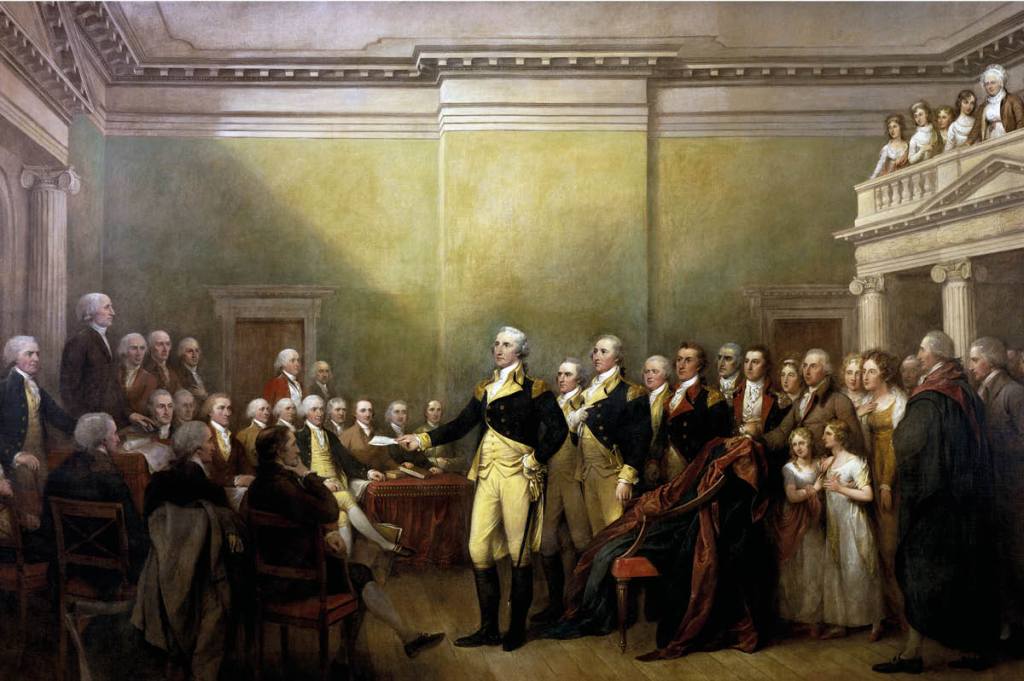In a recent Saturday Night Live sketch, comedian Nate Bargatze portrayed General George Washington addressing his troops around a campfire in 1777, as they ask themselves what the Revolution is for. Washington shares some of his dreams for the new American republic — though he dodges difficult questions about slavery — in an effort to inspire his men to fight on.
The writers take full advantage of the fact that a number of peculiarly American things, such as our version of football (in which feet rarely figure) or our complicated system of weights and measures, seem rather odd to the rest of the world. “We will be free to measure liquids in liters and milliliters, but not all liquids,” the general explains. “Only soda, wine and alcohol. For milk and paint, we will use gallons, pints and quarts.” Washington may be dignified, but he’s hard to understand, even to his own men.
A more dignified, but perhaps even more difficult, representation appears in John Trumbull’s painting “General George Washington Resigning His Commission” (1824), painted 200 years ago. It is an image known to most Americans from schoolbooks, though it’s not the most famous of the four massive Trumbull canvases in the Capitol Rotunda. That honor belongs to Trumbull’s 1818 depiction of the signing of the Declaration of Independence, which hangs nearby along with his paintings of the “Surrender of General Burgoyne” (1821) and the “Surrender of Lord Cornwallis” (1820). While all four have become iconic, the image of Washington’s return to private life seems especially evocative in the present political atmosphere.
As a colonial artist without regular access to European art, apart from stints studying in London with such Anglo-American artists as Benjamin West, it is all the more remarkable that Trumbull even attempted to paint on a scale in keeping with that of a Venetian council chamber or a reception room at Versailles.
And there are certainly elements in his work that recall the Old Masters. Take, for example, the presence in the “Resignation” of Martha Washington and her grandchildren, none of whom in fact witnessed this event. They appear in the visitors’ gallery at upper right, looking down into the Maryland State House where the scene plays out on center stage.
Trumbull makes the decision to miniaturize these imaginary onlookers while making them recognizable to their contemporaries. If he was trying it as a technical trick, to create the illusion of depth, the distant spectators seem anachronistic, reminiscent of the moments in Quattrocento paintings where people peep out of windows and the artist’s patrons lean over balconies to witness miracles.
Trumbull’s careful attention to the accurate portrayal of those in attendance also hearkens back to later paintings such as Rembrandt’s “The Anatomy Lesson of Dr. Nicolaes Tulp” (1632), which bears the recognizable likenesses of the picture’s donors. Within a decade, however, Rembrandt began the process of rejecting this insistence upon perfectly executed group portraiture in “The Night Watch” (1642), where some of the participants are clearly visible, but others are lost in shadow. By comparison, Trumbull’s depiction of Washington’s resignation seems more static, less progressive than Rembrandt’s. It is critical to understand the political and stylistic context in which Trumbull was working, for the timing of the commission he received was no accident.
The four Rotunda paintings were commissioned by Congress in 1817, five years after the last war between America and Britain had seen the Capitol and the White House burned by English troops. The young republic needed to shore up its foundations, for although the military battles had ended — at the time, no one knew for how long — the battle of words was still being fought on both sides. Today, when America and Britain are described as enjoying a “special relationship,” we forget that, for the first part of it, the United States suffered from an inferiority complex.
The America that emerged from the War of 1812 needed to remind itself of its founding principles, and why it was different from the European powers that had previously dominated it, before the generation of revolutionaries that had brought it into being were all gone. Telling the nation’s story through vast historical paintings, a tradition itself rooted in the Classical age, was a way to counteract the notion that the American experiment was a doomed farce, and that Americans themselves were uncouth and lacking in character. Trumbull’s images depicting the Revolution with dignity and strength, to be placed in the vast, domed Rotunda of a grander Capitol than that torched by the British, were intended to remind both citizens and visitors that America was a fundamentally different place.
If Trumbull’s imagining of Washington’s resignation seems more like a bas-relief than a painting, this was as much intentional as it was due to his limited eyesight (he had vision in only one eye). Trumbull belongs to the Neoclassical period of Western art, which emerged at the end of the eighteenth century as a reaction against the perceived coquettishness and frippery of the Rococo. Neoclassicism has a kind of hard-boiled quality, typically derived from somewhat inaccurate ideas about Ancient Greek and Roman art — think of paintings by Jacques-Louis David or the sculptures of Bertel Thorvaldsen.
As Congress clearly understood when commissioning Trumbull’s canvases, the presentation of key events from the founding of the nation to all who visited the classically-inspired seat of American democracy would serve as powerful visual reminders of national values and principles. To present those images in the suitably grand setting where they would be displayed, some extraordinary creativity would need to be employed.
I recently had the privilege of spending time before Trumbull’s work, accompanied by a highly knowledgeable staff member of the office of the Architect of the Capitol, the agency that cares for the building and its contents. We discussed the history behind the Trumbull commission, and I learned that, prior to their installation in the Rotunda, the canvases had gone on tour to major cities of the then-much smaller United States. At a time before museums or art galleries, such tours brought art to members of the public who might otherwise never see these works in person.
As my guide pointed out, Trumbull’s image of Washington’s resignation of his commission is, at least in subject matter, perhaps the most radical of the canvases that line the Capitol Rotunda. Trumbull himself suggested, and then-President James Madison agreed, that the event was an important one that ought to be commemorated as an example for the nation. Washington’s contemporaries could not fathom what the general had done: it was the antithesis of the countless occasions on which victorious military leaders have set themselves up permanently as rulers. Trumbull’s painting has reminded generations of Americans that public service is a duty to be taken up for a time and then put down again, as in the example of the Roman statesman Cincinnatus, to whom Washington was frequently compared when he relinquished power in order to return to his plow.
When Trumbull depicts Washington handing back power to the people, he presents a dignified scene devoid of regal pageantry, as befits republican government. As Washington rises from his throne-like chair, he casts aside the great mantle in which he had been physically and metaphorically wrapped. There is no shouting or cheering, no grandiose procession of costumed bowing and scraping flunkies.
Nor is there any antisocial and uncivilized behavior in the hall where this event is taking place, a fact made all the more poignant when reflecting upon what took place in the very spot where Trumbull’s painting now hangs, three years ago. No doubt there were many at the end of the Revolutionary War who did not want Washington to stand down; the man himself, however inscrutable he may have seemed at times, proved master of his own personal ambitions for the greater good of those whom he served.
As the United States enters another presidential election cycle in 2024, the peaceable taking up and laying down of power remains a philosophical cornerstone of the American system of government. It is true that what was once viewed as an incredibly radical idea has been challenged or rejected by some in recent years. If not removed via the ballot box, term limits or dire personal circumstances, some modern American politicians attempt to remain in power for as long as possible, rather than serving for a self-limited, brief period of time. Trumbull and those who commissioned him would have considered this antithetical to the foundational principles of American democracy.
It is also why, for contemporary audiences, this depiction of a singular, very American moment in history manages to retain a significant power all its own.
This article was originally published in The Spectator’s January 2024 World edition.





















